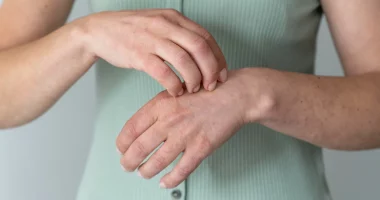Bruises may happen not only in soft tissues, like muscles and skin but also in bones. When you get a bone bruise, you might notice swelling, the skin changing color, stiffness, and joint pain.
Individuals often know what it looks and feels like when muscles and soft tissues get bruised. These areas become swollen, discolored, and sore after an injury. Bone bruises are quite the same, but they may be more painful and take more time to cure.
Typically, bone bruises heal within about three months. However, in some cases, it might take up to one year for a bone bruise to fully go away.
What is it?
A bone bruise happens when you injure or hit a bone. When this occurs, fluid and blood can accumulate internal side of the bone marrow, leading to swelling and pain.
In the past, researchers called bone bruises “bone marrow edema.” This term was used after a study in 1988 where researchers found ten individuals with severe pain in their knees and hips. These people showed changes in their bone marrow density on an MRI scan, which couldn’t be seen on an X-ray.
Today, healthcare providers might call this condition a “bone contusion,” “osseous contusion,” and “bone bruise.” You may have a bone bruise by itself, but it may also be a sign of other injuries like torn ligaments or fractures.
Inside bones, there is a network of contributing tissues called trabeculae. When you have a complete bone fracture, it means all the trabeculae in that part of the bone fail, causing a break. It is like a step prior to a fracture. In a particular episode, only a few of the trabeculae are cracked, not all of them.
Symptoms
Bone bruises can cause several symptoms. These include swelling, ongoing pain or sensitivity even after any visible skin bruising has gone away, and a change in color of the skin around the affected area. If the injury happens close to a joint, additional symptoms may arise. These can include pain in the joint near where the impact occurred, swelling of the joint, and stiffness or trouble functioning the joint normally. These symptoms can vary in severity depending on the location and extent of the bone bruise.
Types
Bone bruises can be categorized in several ways. One method is based on which area of the bone tissue is affected by the bleeding. For instance:
- Intraosseous bruise: Here, swelling and bleeding happen below the external surface of the bone, within the cavity that houses yellow and red bone marrow.
- Subperiosteal hematoma: This type occurs when blood accumulates below the fibrous membrane that covers the external surface.
- Subchondral lesion: This involves bruising under the cartilage that covers a joint. It can result from a compressive force that squeezes the cells and breaks up the cartilage from the primary bone, or from a rotational crushing force.
Healthcare providers can also classify bone bruises based on their location in the body or their seriousness. These classifications help in understanding the nature and extent of the injury, guiding appropriate treatment strategies.
Causes
Bone bruises may occur due to various causes. They may result from a sudden traumatic incident like a fall, injury, or accident. Alternatively, they can develop gradually from repetitive stress on a joint or bone, like from continuous movements in sports
There are several specific types of injuries that can lead to a bone bruise:
- Direct impact: This occurs when a bone receives a direct blow from an object or person.
- Avulsion injury: Here, the muscle or skin is forcefully pulled away.
- Rotation or twisting: These motions can pull cartilage far from the bone.
- Bone-to-bone contact: When two bones collide, it can cause a bone bruise.
- Neighboring bone damage: Injuries to nearby bones can also lead to bone bruising.
- Joint pressure: Excessive stress on joints, like from jumping or running on hard surfaces, can also cause bone bruises.
Each type of trauma creates a distinct pattern of bruising within the bone, which healthcare providers can identify through imaging techniques.
Diagnosis
Diagnosing a bone bruise usually involves several steps. Initially, healthcare providers will ask about the individual’s symptoms, including when they started and if they have changed. They will also check the affected area for signs like inflammation and changes in skin color. If the hurt is near a joint, the healthcare provider might move it or ask the person to move to see if there are any issues with mobility.
To confirm a bone bruise or another injury, the healthcare provider can suggest medical imaging. While an X-ray can eliminate a fracture, it usually doesn’t show bone bruises. For an accurate diagnosis of a bone bruise, an MRI scan is necessary. MRI scans can reveal the specific changes in bone tissue that indicate a bruise, helping the doctor determine the best course of treatment.
Treatment
Treatment for bone bruises typically focuses on managing symptoms and supporting natural healing processes, as there are no proven methods to accelerate recovery. In most cases, bone bruises will heal over time without specific interventions. However, individuals can take steps to alleviate discomfort and promote healing, such as resting the affected bone or joint and keeping it elevated above heart level to reduce swelling. Applying cold packs multiple times daily and taking pain relievers like acetaminophen can also help manage inflammation and pain.
For bruises affecting weight-bearing bones like the feet or legs, it may be necessary to temporarily modify activities. Healthcare providers can provide guidance on when it’s safe to resume normal activities and whether additional support, such as wearing a brace, is beneficial.
People involved in contact sports or physically demanding jobs should prioritize wearing the correct protective gear to reduce the risk of further injury to their bones. Additionally, maintaining an adequate daily intake of vitamin D and calcium is essential for supporting overall bone health, which can contribute to faster recovery from bone bruises and reduce the risk of future bone-related issues.
When to consult a healthcare provider
If you think you have a bone bruise, it’s important to see a healthcare provider. Sometimes, a bone bruise can be an area of a more severe injury, so it’s crucial to get a medical opinion.
The signs of a bone bruise may be the same as those of other conditions like arthritis. A healthcare provider can do tests to make sure it’s just a bone bruise and not something else.
You should contact a doctor if the swelling doesn’t go down, gets worse, or if the pain gets worse and isn’t helped by pain relievers. These signs could indicate a need for medical attention to ensure proper treatment and care.
Summary
Bone bruises typically result from injury or repetitive stress and can cause pain, swelling, and changes in skin color. They are diagnosed through symptoms, physical examination, and imaging like MRI scans. Treatment focuses on managing symptoms with rest, elevation, cold therapy, pain medication, and sometimes braces.
Recovery time varies, and it’s important to avoid activities that worsen symptoms. Seeking medical advice is crucial to rule out more serious conditions and to determine when it’s safe to resume normal activities. Protective gear and adequate nutrition support bone health and can prevent further injury.









